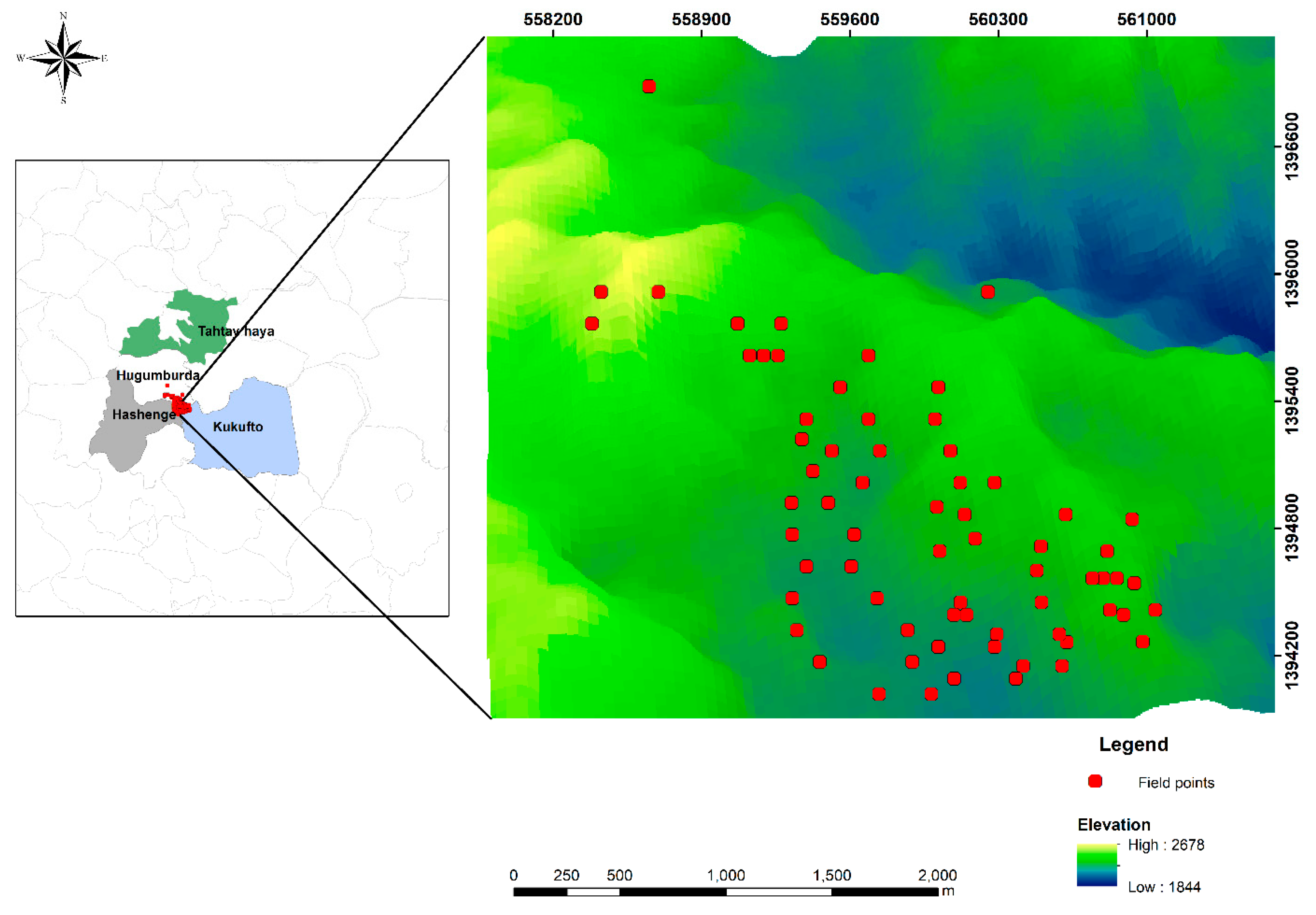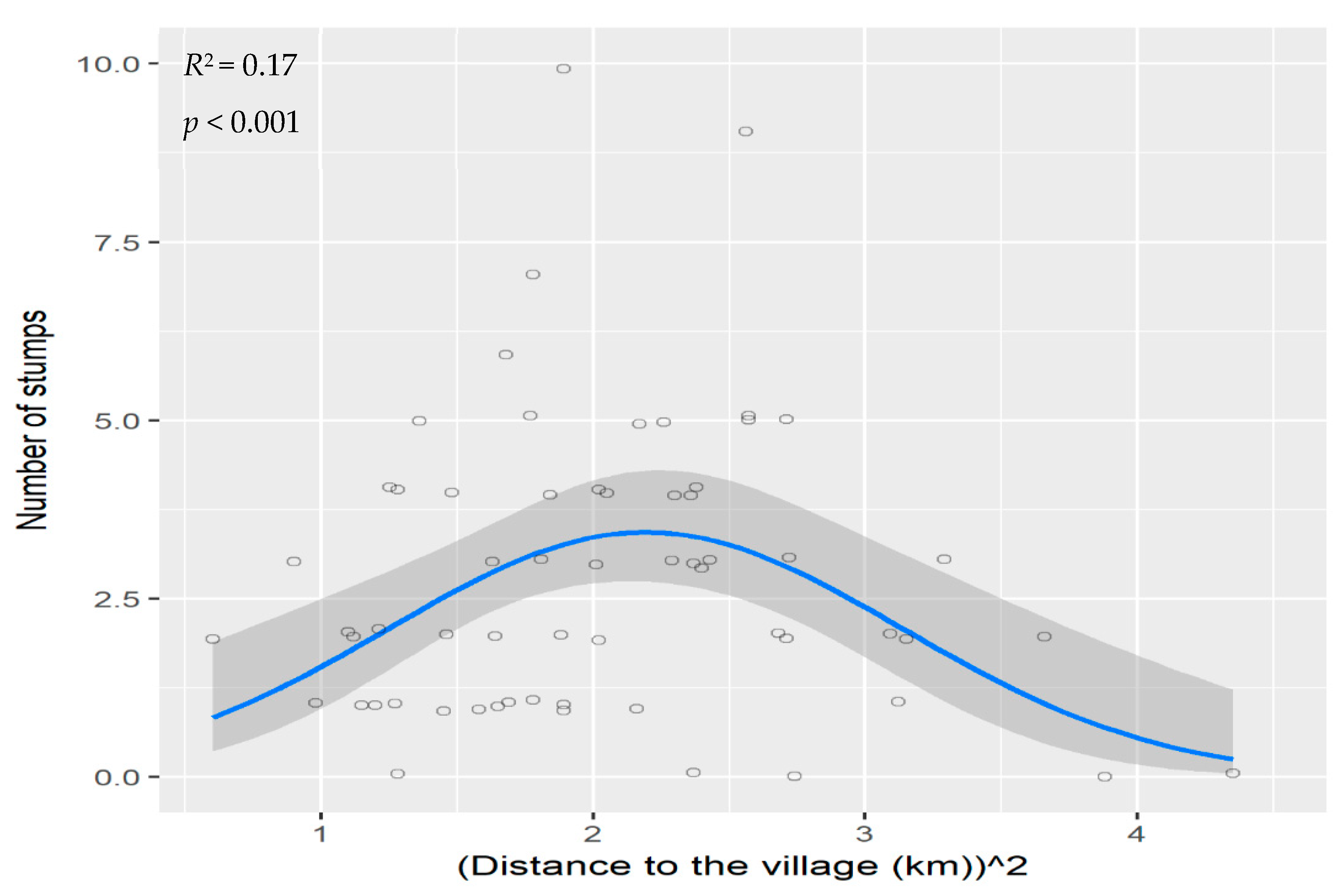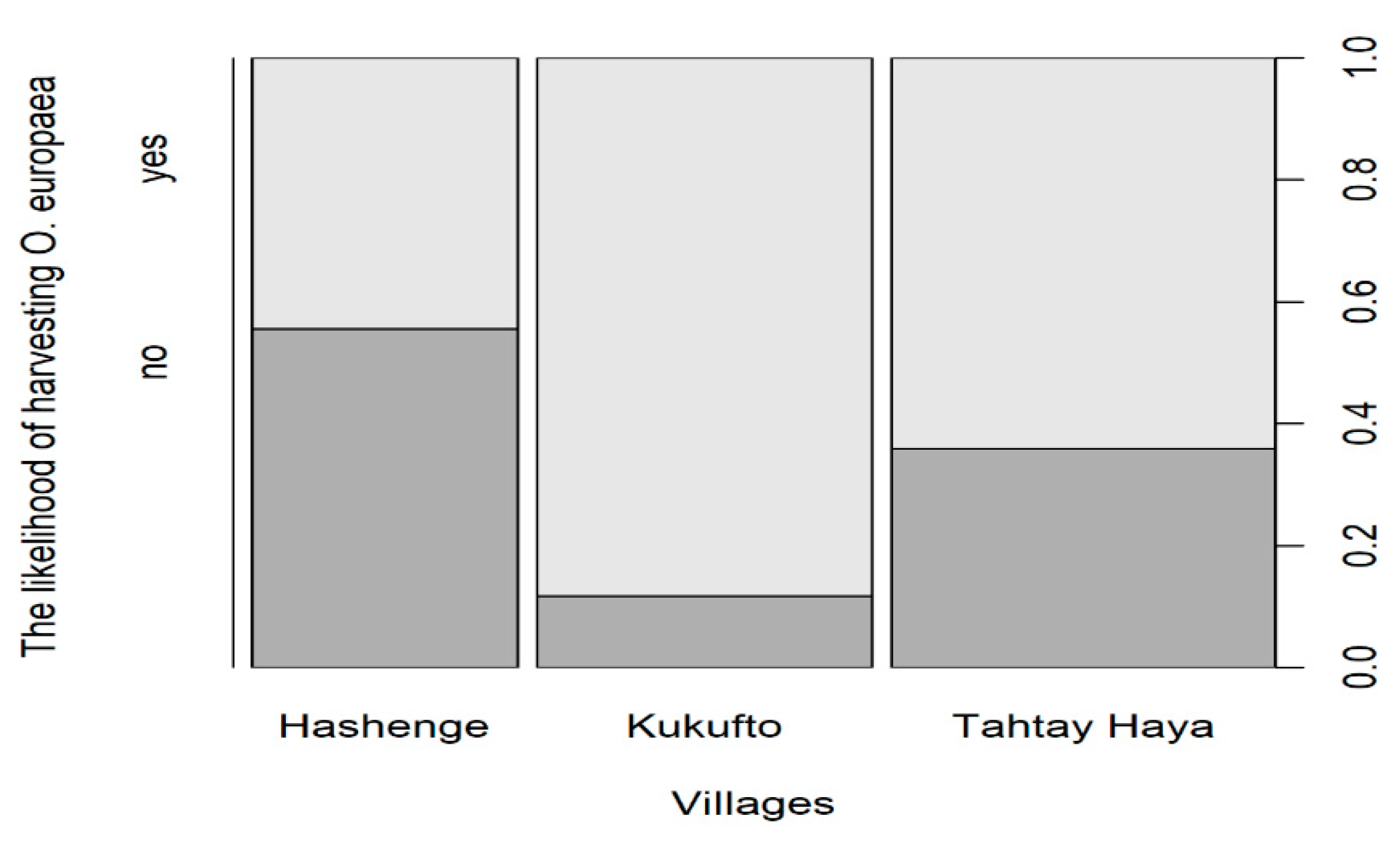Illegal Harvesting of Locally Endangered Olea europaea Subsp. cuspidata (Wall. ex G. Don) Cif. and Its Causes in Hugumburda Forest, Northern Ethiopia
Abstract
1. Introduction
2. Materials and Methods
2.1. Study Area
2.2. Data Collection
2.2.1. Ecological Survey
2.2.2. Socioeconomic Survey
2.3. Data Analysis
2.3.1. Data Preparation
2.3.2. Statistical Analysis
3. Results
3.1. Amount of O. europaea Wood Harvested
3.2. Factors Influencing the Amount of O. europaea Harvested
3.3. Household Consumption of O. europaea Wood
3.4. The Main Uses of O. europaea Wood
4. Discussion
5. Conclusions
Author Contributions
Acknowledgments
Conflicts of Interest
References
- Friis, I. Forests and Forest Trees of Northeast Tropical Africa: Their Natural Habitats and Distribution Patterns in Ethiopia, Djibouti and Somalia; Her Majestry’s Stationery Office: London, UK, 1992.
- Bekele, T. Vegetation Ecology of Remnant Afromontane Forests on the Central Plateau of Shewa, Ethiopia; Opulus Press: Uppsala, Sweden, 1993. [Google Scholar]
- Teketay, D. Seed and regeneration ecology in dry Afromontane forests of Ethiopia: I. Seed production-population structures. Trop. Ecol. 2005, 46, 29–44. [Google Scholar]
- Hawando, T. Desertification in Ethiopian Highlands. Available online: http://www.rala.is/rade/ralareport/Hawando.pdf (accessed on 14 August 2018).
- Teketay, D. Seed and regeneration ecology in dry Afromontane forests of Ethiopia: II. Forest disturbances and succession. Trop. Ecol. 2005, 46, 45–64. [Google Scholar]
- Girma, A.; Mosandl, R.; Kateb, H.E.; Masresha, F. Restoration of degraded secondary forest with native species: A case study in the highland of Ethiopia. Scand. J. For. Res. 2010, 25, 86–91. [Google Scholar] [CrossRef]
- Kituyi, E.; Marufu, L.; Huber, B.; Wandiga, S.O.; Jumba, I.O.; Andreae, M.O.; Helas, G. Biofuel consumption rates and patterns in Kenya. Biomass Bioenergy 2001, 20, 83–99. [Google Scholar] [CrossRef]
- Njiti, C.F.; Kemcha, G.M. In Survey of Fuel Wood and Service Wood Production and Consumption in the Sudano-Sahelian Region of Central Africa: The Case of Garoua, Cameroon and Its Rural Environs. Available online: https://hal.archives-ouvertes.fr/file/index/docid/135780/filename/T222Njiti.pdf (accessed on 14 August 2018).
- Teklehaimanot, Z.; Healey, J. Biodiversity Conservation in Ancient Church and Monastery Yards in Ethiopia. Available online: http://www.darwininitiative.org.uk/documents/10031/14005/10-031%20AR1%20-%20edited.pdf (accessed on 14 August 2018).
- Gebreslassie, T.; Hagos, G.; Abraham, M. Assessing households’ fuel wood tree species preference, the case of Desa’a afro alpine forest, Tigray. Civ. Environ. Res. 2014, 6, 48–51. [Google Scholar]
- Woldemichael, L.K.; Bekele, T.; Nemomissa, S. Vegetation composition in Hugumbirda-Gratkhassu National Forest Priority Area, South Tigray. Momona Ethiop. J. Sci. 2010, 2, 27–48. [Google Scholar] [CrossRef]
- Aynekulu, E. Forest Diversity in Fragmented Landscapes of Northern Ethiopia and Implications for Conservation. Ph.D. Thesis, Rheinschen Friedrich-Wilhems Universitat, Bonn, Germany, 2011. [Google Scholar]
- Kidane, L.; Nemomissa, S.; Bekele, T. Human-forest interfaces in Hugumburda-Gratkhassu National Forest Priority Area, North-eastern Ethiopia. J. Ethnobiol. Ethnomed. 2018, 14, 17. [Google Scholar] [CrossRef] [PubMed]
- Negash, L. Indigenous Trees of Ethiopia: Biology, Uses and Propagation Techniques; Department of Biology, Addis Ababa University: Addis Ababa, Ethiopia, 1995. [Google Scholar]
- Negash, L. Vegetative propagation of the threatened African wild olive [Olea europaea L. subsp. cuspidata (Wall. ex DC.) Ciffieri]. New For. 2003, 26, 137–146. [Google Scholar] [CrossRef]
- Viswanathan, T. Endangered tree species in Northern Ethiopia. Environ. Conserv. 1986, 13, 71–72. [Google Scholar] [CrossRef]
- Negash, L. Successful vegetative propagation techniques for the threatened African pencil cedar (Juniperus procera Hoechst. ex Endl.). For. Ecol. Manag. 2002, 161, 53–64. [Google Scholar] [CrossRef]
- Aynekulu, E.; Denich, M.; Tsegaye, D. Regeneration Response of Juniperus procera and Olea europaea subsp cuspidata to exclosure in a dry Afromontane forest in northern Ethiopia. Mt. Res. Dev. 2009, 29, 143–152. [Google Scholar] [CrossRef]
- CBD Convention on Biological Diversity (CBD) Ethiopia’s 4th Country Report. Available online: https://www.cbd.int/doc/world/et/et-nr-04-en.pdf (accessed on 14 August 2018).
- Parent, G. Manual for woody biomass inventory. In Woody Biomass Inventory and Strategic Planning Project; Ministry of Agriculture: Addis Ababa, Ethiopia, 2000. [Google Scholar]
- Zuur, A.F.; Ieno, E.N.; Elphick, C.S. A protocol for data exploration to avoid common statistical problems. Methods Ecol. Evol. 2010, 1, 3–14. [Google Scholar] [CrossRef]
- Ekström, J. A Generalized Definition of the Polychoric Correlation Coefficient. 2011. Available online: https://escholarship.org/uc/item/583610fv (accessed on 14 August 2018).
- Gebreslassie, T.; Gebreslassie, H. Current status and future prospect of Olea europaea and Juniperu procera on Desa’a Afro Alpine forest, North Ethiopia. J. Nat. Sci. Res. 2014, 4, 62–65. [Google Scholar]
- Meier, E. Wood!: Identifying and Using Hundreds of Woods Worldwide. Wood Database, 2015. Available online: https://www.amazon.com/Identifying-Using-Hundreds-Worldwide-2015-10-10/dp/B01FGP9964 (accessed on 14 August 2018).
- Kassa, A.; Konrad, H.; Geburek, T. Mating pattern and pollen dispersal in the wild olive tree (Olea europaea subsp cuspidata). Tree Genet. Genomes 2018, 14, 3. [Google Scholar] [CrossRef]
- Wubet, T.; Kottke, I.; Teketay, D.; Oberwinkler, F. Mycorrhizal status of indigenous trees in dry Afromontane forests of Ethiopia. For. Ecol. Manag. 2003, 179, 387–399. [Google Scholar] [CrossRef]
- Long, H.S.; Tilney, P.M.; van Wyk, B.E. The ethnobotany and pharmacognosy of Olea europaea subsp africana (Oleaceae). South Afr. J. Bot. 2010, 76, 324–331. [Google Scholar] [CrossRef]
- Flemmig, J.; Kuchta, K.; Arnhold, J.; Rauwald, H.W. Olea europaea leaf (Ph.Eur.) extract as well as several of its isolated phenolics inhibit the gout-related enzyme xanthine oxidase. Phytomedicine 2011, 18, 561–566. [Google Scholar] [CrossRef] [PubMed]
- Leak, W.B. The J-shaped probability distribution. For. Sci. 1965, 11, 405–409. [Google Scholar]
- Westphal, C.; Tremer, N.; von Oheimb, G.; Hansen, J.; von Gadow, K.; Härdtle, W. Is the reverse J-shaped diameter distribution universally applicable in European virgin beech forests? For. Ecol. Manag. 2006, 223, 75–83. [Google Scholar] [CrossRef]
- Leach, G.; Mearns, R. Beyond the Woodfuel Crisis: People, Land and Trees in Africa; Routledge: London, UK, 2013. [Google Scholar]
- Kidane, L.; Nemomissa, S.; Woldu, Z. The effects of disturbance on the population structure and regeneration potential of five dominant woody species–in Hugumburda-Gratkhassu National Forest Priority Area, North-eastern Ethiopia. Afr. J. Ecol. 2016, 54, 20–28. [Google Scholar] [CrossRef]
- Teye, J.K. Corruption and illegal logging in Ghana. Int. Dev. Plan. Rev. 2013, 35, 1–19. [Google Scholar] [CrossRef]
- Lee, J.-H.; Sigmund, K.; Dieckmann, U.; Iwasa, Y. Games of corruption: How to suppress illegal logging. J. Theor. Biol. 2015, 367, 1–13. [Google Scholar] [CrossRef] [PubMed]
- Hofstad, O. A theoretical analysis of illegal wood harvesting as predation–With two Ugandan illustrations. Scand. For. Econ. 2008, 42, 441–452. [Google Scholar]





| Variables | Description |
|---|---|
| Response Variable | |
| Likelihood of harvesting O. europaea from Hugumburda Forest | The probability that a household harvested O. europaea wood directly from the forest (yes or no) |
| Candidate explanatory variables: | |
| Villages | Hashenge, Kukufto, and Tahtay Haya (administrative units) |
| Age class | Age of the household head in years (15–24, 25–44, 45–64, or 64 + ) |
| Family size | Number of family members |
| Education level | Number of school years completed by the household head (0, 1–5, 6–10, 11–12, or 12 + ) |
| Household head | Male-headed or female-headed household |
| Marital status | Household situation with regard to whether household head is single, married, separated, divorced, or widowed |
| Economic status | Whether the household is poor, middle-income, or rich |
| Use of O. europaea wood for fuel wood | A household using O. europaea wood for fuel wood (yes or no) |
| Use of O. europaea wood for fumigation | A household using O. europaea wood for fumigation (yes or no) |
| Places obtaining O. europaea wood for fumigation | A household obtaining O. europaea wood for fumigation (from backyard, market or the forest) |
| Frequency of use of O. europaea wood for fumigating the home | The frequency of a household head using O. europaea wood to fumigate his or her own house (daily, every three days, once per week, or three times per week) |
| Use of O. europaea wood for farming implements | A household using O. europaea wood for farming implements (yes or no) |
| Places obtaining O. europaea wood for making farm implements | A household obtaining O. europaea wood for making farming implements (from backyard, market or the forest) |
| A household head planted O. europaea in his/her garden | A household that has planted an O. europaea tree (yes or no) |
| β | SE | t | p | |
|---|---|---|---|---|
| Intercept | 0.423 | 0.094 | 4.480 | <0.001 |
| Elevation (m a.s.l.) | 0.262 | 0.095 | 2.757 | <0.001 |
| β | SE | z | p | |
|---|---|---|---|---|
| Intercept | 1.222 | 0.110 | 11.072 | <0.001 |
| Distance from the nearest village (km) | 0.118 | 0.119 | 0.987 | 0.324 |
| Distance to the nearest village (km2) | −0.333 | 0.100 | −3.339 | <0.001 |
| Types of Energy | Preferred Species for Fuel Wood | No. of Respondents | Rank |
|---|---|---|---|
| Fuel wood | Cadia purpurea Willd. O. europaea (Wall. ex G. Don) Cif. Carissa edulis L. Eucalyptus camaldulensis Dehnh. Dodonaea viscosa (L.f.) Benth. var. angustifolia Juniperus procera Hochst. ex Endl. Clerodendrum villosum De Wild Others | 57 51 15 9 5 1 1 15 | 1 2 3 4 5 6 7 – |
| Cow dung | 5 | – | |
| Electricity | 2 | – |
| Species Used for Cleaning Teeth | Total Score | Percentage | Rank |
|---|---|---|---|
| O. europaea (Wall. ex G. Don) Cif. | 154 | 92.8 | 1 |
| Dodonaea viscosa (L.f.) Benth. | 57 | 34.3 | 2 |
| Pittosporum viridiflorum Sims | 15 | 9.0 | 3 |
| Cardia purpurea Willd. | 11 | 6.6 | 4 |
| Euclea racemosa subsp. schimperi A.DC. F. White | 6 | 3.6 | 5 |
| Others | 38 | 22.9 | 6 |
| β | SE | z | P | |
|---|---|---|---|---|
| Intercept (Hashenge) | −0.223 | 0.387 | −0.576 | 0.565 |
| Kukufto | 2.238 | 0.658 | 3.400 | 0.001 |
| Tahtay Haya | 0.803 | 0.511 | 1.570 | 0.116 |
© 2018 by the authors. Licensee MDPI, Basel, Switzerland. This article is an open access article distributed under the terms and conditions of the Creative Commons Attribution (CC BY) license (http://creativecommons.org/licenses/by/4.0/).
Share and Cite
Ourge, M.; Hofstad, O.; Klanderud, K.; Eldegard, K.; Tewolde-Berhan, S. Illegal Harvesting of Locally Endangered Olea europaea Subsp. cuspidata (Wall. ex G. Don) Cif. and Its Causes in Hugumburda Forest, Northern Ethiopia. Forests 2018, 9, 498. https://doi.org/10.3390/f9080498
Ourge M, Hofstad O, Klanderud K, Eldegard K, Tewolde-Berhan S. Illegal Harvesting of Locally Endangered Olea europaea Subsp. cuspidata (Wall. ex G. Don) Cif. and Its Causes in Hugumburda Forest, Northern Ethiopia. Forests. 2018; 9(8):498. https://doi.org/10.3390/f9080498
Chicago/Turabian StyleOurge, Mekdes, Ole Hofstad, Kari Klanderud, Katrine Eldegard, and Sarah Tewolde-Berhan. 2018. "Illegal Harvesting of Locally Endangered Olea europaea Subsp. cuspidata (Wall. ex G. Don) Cif. and Its Causes in Hugumburda Forest, Northern Ethiopia" Forests 9, no. 8: 498. https://doi.org/10.3390/f9080498
APA StyleOurge, M., Hofstad, O., Klanderud, K., Eldegard, K., & Tewolde-Berhan, S. (2018). Illegal Harvesting of Locally Endangered Olea europaea Subsp. cuspidata (Wall. ex G. Don) Cif. and Its Causes in Hugumburda Forest, Northern Ethiopia. Forests, 9(8), 498. https://doi.org/10.3390/f9080498





